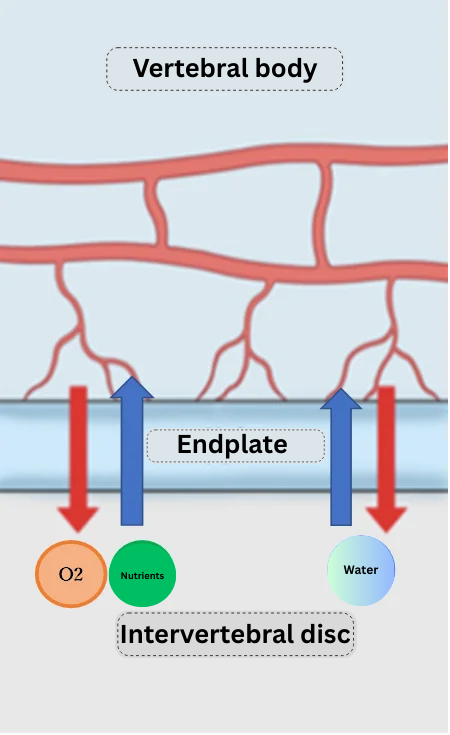May 27, 2023

We have previously discussed muscles and blood flow, but this time we will focus on intervertebral discs and blood flow specifically.
Intervertebral discs receive oxygen and nutrients from the blood in the same way as muscles do.
The main component of the intervertebral disc is water, and because this type of tissue is not vascularized, there are no blood vessels (and blood supply) in the disc itself.
Therefore, as shown in the illustration, the disc receives oxygen and nutrients from capillaries in the bone through a type of tissue called the endplate (with a thin cartilage).
This is associated with the pressure in the disc, which also takes water in and out of the disc as well as removes waste products.
The intervertebral discs receive strain even in their default position, receiving 1.4 times more strain in a seated position than in a standing one.
Moreover, the disc is prone to degenerative changes associated with aging, and these changes are said to begin as early as the late teenage years.
Because we are talking about a non-vascularized tissue that is constantly exposed to high strain, it is imperative to ensure that the disc is well nourished in order to prevent deterioration.
As was just explained above, there are no blood vessels in the intervertebral disc. Nutrients are received via the blood circulation, going from the large blood vessels to the capillaries, down to the endplate, and then into the intervertebral disc.
If blood circulation is poor, then what changes may occur within the body?
If the blood lacks fluidity, it may take longer than usual for the oxygen/nutrients to be delivered to the body.
Nerves, blood vessels, and muscles will perform repair work when injured, but if the quality and blood supply is poor, the nutrients needed to repair the tissues will not reach them at the right time, and recovery will take longer. In this, intervertebral discs are no exception.
That is why it is critical to keep one's blood in good condition.
Other causes of disc deterioration include disorders of the autonomic nervous system and smoking.
When the autonomic nervous system is disturbed, blood vessels constrict and impedes blood flow, which may contribute to not only aging the disc but also leading to an aggravation of the pain and numbness.
The nicotine present in cigarettes causes the capillaries around the intervertebral disc to contract, which prevents adequate nutrition from reaching the disc, damaging it and weakening its cushioning properties.
Although we offer disc treatment at our clinic, the main cause for disc deterioration is deeply related not only to one's usual posture but also to one's daily life, such as diet and blood circulation. At our clinic, we provide treatments that take into account such lifestyle factors.
If you are suffering from back pain, we invite you to pay a visit to our clinic.
ILC International Back Pain Clinic Tokyo
Takeshi Deguchi, Registered Dietitian



